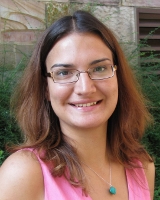2011 REU and REV Program Participant Profiles: Dana-Adriana Botesteanu
 |
Majors: Mathemtics, French |
What is the purpose of your research?
The purpose of the project I am working on is to determine the validity of the Differential Allocation Hypothesis (DAH), which states that mother birds will invest more in the eggs if the offspring come from a more attractive male. To date, few comprehensive statistical and mathematical models have been developed to test whether differential allocation happens and in what conditions.
What does your research ultimately accomplish?
Ultimately, we hope to better understand the conditions under which differential allocation occurs and how attractive the male bird has to be before the female allocates more resources into the eggs. While the two models we are developing take into account the different degrees of polygamy in birds, they could be adapted to any species, and could potentially help understand how DAH fits in the bigger picture of reproductive investment, not just specifically the one related to birds.
![]()
Living in a ‘math bubble’ during the academic year, I tend to forget the numerous connections mathematics has with the other sciences. It is truly an eye-opener to realize that when you combine knowledge in different areas, you can arrive at powerful results.
![]()
– Dana-Adriana Botesteanu, REU participant
What were your favorite parts of the REU/REV program?
Living in a 'math bubble' during the academic year, I tend to forget the numerous connections mathematics has with the other sciences. This program has definitely shown me the importance of getting together, sharing our personal knowledge in the fields we study, and putting everything together to try to explain 'a bigger picture.' It is truly an eye-opener to realize that when you combine knowledge in different areas, you can arrive at powerful results.
What new experiences did you gain that have helped you today?
I gained a better understanding of the challenges involved when coming up with a mathematical model, especially when there is little to no work previously published on the topic you're researching. While I had analyzed mathematical models before, it is a novel experience when you contribute to writing one, and then discover little by little what its shortcomings are and what improvements you could make.
Would you recommend our program to others?
Definitely! If you're thinking about going in applied mathematics, then an interdisciplinary program like [the one] NIMBioS offers will definitely give you a taste of what collaboration with people from different backgrounds entails and how important group work is when everyone in the group brings complementary skills. Also, the panels on graduate school and careers were very helpful in deciding what you might want to do with your life after graduation.
Where do you see yourself in 10 years?
This is a very difficult question! I envision myself doing research at a national institute or teaching mathematics at a college level. Combining both these activities would be a major accomplishment, I believe.
NIMBioS
1122 Volunteer Blvd., Suite 106
University of Tennessee
Knoxville,
TN 37996-3410
PH: (865) 974-9334
FAX: (865) 974-9461
Contact NIMBioS


